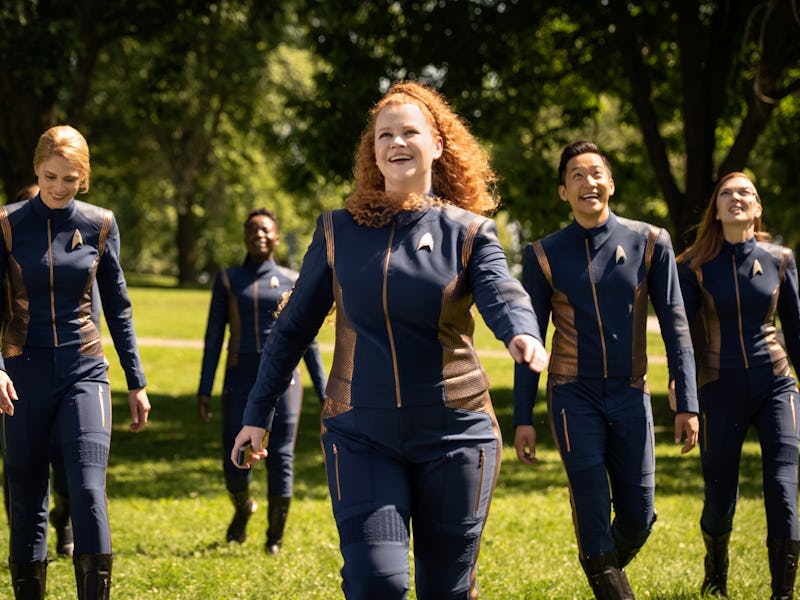Star Trek: Discovery borrows a brilliant idea from The Next Generation
Season 3 feels awfully familiar all of a sudden.

Star Trek: Discovery is suddenly the new Next Generation. After two seasons of dark, serialized storytelling, Season 3 of Discovery has given itself a TNG-style makeover. After Episode 5 of Season 3, "Die Trying,"it's become increasingly clear that the new approach in Discovery Season 3 isn't — as many predicted —to explore a dark, dystopic side of Star Trek. Instead, the franchise flagship has reinvented itself as an optimistic, political sci-fi show.
Season 3 of Star Trek: Discovery is tonally and structurally a lot closer to The Next Generation than ever been before. And it's not just because of the sudden jump into the far future. Here are three ways Discovery is borrowing from the basic format of TNG and why the show is better for it.
Spoilers ahead for Discovery Season 3, through Episode 5, "Die Trying."
The premiere episode of Discovery Season 3 felt like a substantial reboot. Yet by Episode 3, "People of Earth," the show seemed to settle into a very familiar pattern. So far, every new episode of Discovery following Burnham's reunion with the crew has played out like a self-contained episode of The Next Generation.
Sure, there are larger questions running through this season — What is the Burn? What's up with Burnham's gap year? Where is the rest of the Federation? Even so, each episode after the premiere feels more like it has a beginning, middle, and end than nearly anything in the previous two seasons. Obviously, this makes Discovery more like most pre-21st century Star Trek, and the spirit of TNG seems to be alive and well on Discovery. Here's why.
Who's your favorite new TV character in 2020? Take the Inverse fan-favorites survey!
What are we doing this week?
Discovery is picking one ethical dilemma to tackle each week
In Season 1 and Season 2 of Discovery, most episodes took place in a shared narrative context. In Season 1, most of the storylines were connected to either the Klingon War or the Mirror Universe. In Season 2, most of the plots were connected to the mystery of the Red Angel and the battle against Control.
Discovery Season 3 is less reliant on these bigger season-long questions, instead letting each individual episode define the tone. This is exactly like The Next Generation. The status quo of TNG's political galaxy was less important than the problems faced in individual episodes. Discovery isn't ignoring the turmoil of the new future, but that context is more seamlessly incorporated this season. To put it another way, the conflict between Earth and Titan in "People of Earth," felt like a random TNG episode in which Picard settles a dispute between a couple of random alien planets. The difference was this time, the backstory of the Burn helped bring that type of planetary-neighbors problem closer to home. Literally.
This scene had tension, but everybody ended-up hugging it out.
Discovery Season 3 is more upbeat than Seasons 1 and 2
Although Discovery is still darker than TNG and TOS, this season is decidedly more upbeat than the previous two. Sure, Saru and Burnham are still arguing more than Riker and Picard ever would have, and Detmer is having meltdowns that Sulu only hinted at, but overall, the mood of the DISCO crew is lighter. Just think about the number of episodes in which characters have been smiling and hugging as opposed to say, anything in Discovery Season 1. In both "People of Earth," and "Die Trying," the crew of the USS Discovery is united and looking out for each other more than ever before. Michael Burnham might be impatient and frustrated with Starfleet protocol, but she's happier than she's ever been. Like TNG, the crew of the Discovery feels more like an ensemble than in previous seasons.
Finding Burnham was just the beginning of the reunion tour.
Discovery Season 3 Is re-exploring the galaxy
Part of the novelty of early TNG was the idea of revisiting and reinventing classic Star Trek ideas in a new future setting. In its first few seasons from 1987 to 1989, TNG basically did a "Where Are They Now?" tour with several classic Trek planets and species; the show rediscovered the Klingons in "Heart of Glory" and the Romulans in "The Neutral Zone." Discovery is taking a similar approach to the Star Trek universe now. If you were a TOS fan in 1987, the way the Klingons and Romulans were presented on TNG felt familiar, but the new century made the context totally different. Discovery's version of this is basically happening every week. In Episode 3, we rediscovered Earth, in Episode 4, the crew visited the planet Trill, and in Episode 5, the headquarters of Starfleet were redefined.
This trick worked on TNG because about a hundred years had passed since Kirk and Spock. Discovery is doing the same thing, but now there are nine centuries in between old Trek and new. In this way, Discovery Season 3's secret real title should probably be Star Trek: Re-Discovery. And once you start to think about it that way, the entirety of Season 3 will start to feel like Star Trek: The Next Next Next Next Generation.
Star Trek: Discovery is streaming now on CBS All Access.